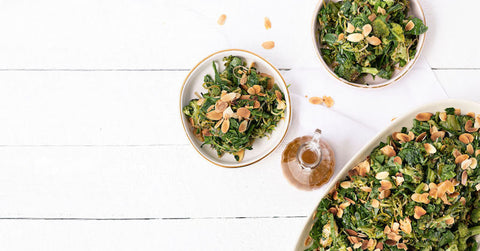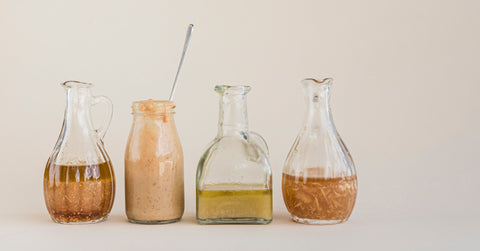Liver Detoxification 101
When the demand placed on our liver is greater than its capacity, many of the dangerous compounds that it usually processes remain in circulation, which can cause a toxic overload.
Our liver is designed to do its job 24/7, and in most healthy people, it does that job pretty well. However, the functions that it performs are incredibly nutrient-intensive, so the best way to ensure that it is functioning optimally is to focus on eating a diverse wholefood diet.1
Here’s a quick overview of the liver’s 3 detoxification phases, as well as the types of foods that help to support each phase.
Phase 1
In phase 1, toxic substances are converted into a form that is easier to process during the later phases.
This process is triggered automatically by the presence of toxic substances in the body & is carried out by a group of enzymes known as the Cytochrome P450 family.2
What most people don’t know about phase 1, is that it actually creates a by-product called “free radicals”. Free radicals are oxygen molecules that are missing a small part of themselves (called an electron). In this state, they are very unstable and will do everything they can to get an extra oxygen molecule. To achieve this, they scavenge molecules from other cells in the body which causes damage to the cell & its DNA. This process is called oxidative stress, and has been linked to various diseases including neurodegeneration, inflammatory diseases and cancer.3,4
One way we can reduce free radical damage is to boost our intake of antioxidants. Antioxidants are compounds that carry an extra electron, which they can “donate” to free radicals without becoming unstable. This is why antioxidants play a significant role in the detoxification process, and also our overall health.5
Phase 1 Supportive Nutrients & Foods
Antioxidants
Found in berries (particularly darkly coloured berries), cherries, citrus, green tea or matcha, turmeric, elderberries, spinach, peppers, dark chocolate, pecans, fresh herbs & cinnamon.
Sulforaphane
Found in cruciferous vegetables such as broccoli, cabbage, cauliflower, kale, kohlrabi, arugula, radishes, brussels sprouts, cress varieties and choy varieties.
Phase 2
In Phase 2, the compounds produced in phase 1 are processed into a form that can be excreted from the body.
Phase 2 has 6 main pathways for transformation, each of which has slightly different processing methods, and therefore, act on different compounds. Each of these pathways are facilitated by a set of enzymes which require unique nutrients, but there are a few common denominators, which are listed below.6
This phase is heavily influenced by a protein called Nrf2 (Nuclear factor erythroid 2 related factor 2). This protein controls how certain genes are expressed. It also regulates the production & level of phase 2 enzymes & antioxidants within the body, which impacts how efficient our detoxification system is.7
Nrf2 has a huge impact on our overall health. In fact, studies have found that animals who are Nrf2-deficient are more likely to experience toxicity from drugs, carcinogens and pollutants.
On the flip side, when they induced Nrf2 activity in these animals, it showed a protective effect against a whole host of what is known as “oxidative stress” diseases including cancer, arthritis, neurological & cardiovascular disease.
Basically, being able to upregulate Nfr2 will help your body to reduce free radicals & process toxic substances more effectively, therefore reducing the risk of inflammation and oxidative diseases.8,9
So as a Nutritionist, here’s the part I love the most - we have the ability to switch on Nrf2 production through what we put in our mouths!
You’ve all heard the saying that food is medicine? Well this is a great example of that principle in action. Specific nutrients from the following foods have been found to boost the production of nrf2: fermented or cultured foods, turmeric, green tea, cacao, grapes, berries, pomegranate, fatty fish (salmon, trout), garlic, ginger, rosemary and cruciferous vegetables.10
Phase 2 Supportive Nutrients & Foods
There are a variety of nutrients needed during phase 2, but here are some of the most important ones:
Isothiocyanates (including Sulforaphane)
Found in cruciferous vegetables such as broccoli, cabbage, cauliflower, kale, watercress, radishes, bok choy, Brussels sprouts etc.11
Sulfur Compounds
Found in allium vegetables such as onions, leeks, garlic, chives, shallots etc.12
Amino Acids
Particularly glutamine, cysteine, glycine, and taurine. Amino acids are building blocks of protein when we eat protein-rich foods, our body breaks them down into amino acids which serve various functions in the body.13
The most bio-available & complete sources of amino acids are animal foods like wild-caught fish, eggs & organic meats.
However, if you eat a plant-only diet, you can also get these complete amino acids profile by consuming marine algae products like spirulina and chlorella, or by combining complementary plant-based food groups like;
- Beans with rice
- Grains with legumes
- Vegetables with grains, nuts & seeds
Phase 3
Phase 3 of detoxification is about transporting & eliminating the compounds that were neutralised in phase 2. The primary route of elimination is through our stool, so it’s crucial to make sure our bowels are healthy enough that we’re having “movements” at least once or twice a day.14
Phase 3 is influenced by three major factors - fibre, gut microbiome health & bile production.
Fibre
Fibre is basically the component of our plant-based foods that can’t be digested or absorbed by the body, and therefore contributes directly to the health of our bowel movements.15
There are 2 types of fibre we can consume:
- Insoluble fibres are fibres that don’t dissolve in water & instead remain mostly unchanged as they move through the digestive tract. Insoluble fibre’s job is to increase the speed of transit time through our digestive system, add bulk to our stools, and increase the regularity of bowel movements.16
- Soluble fibres are fibres that dissolve into a gel-like substance when they come into contact with moisture (like digestive fluids). This type of fibre is particularly helpful for bulking out and softening our stool, making it much easier to pass. Insoluble fibres also act like a sponge in the colon & due to their moisture‐holding properties, they’re able to bind to molecules like bile acids and carcinogens.17
Gut Microbiome Health
Having a robust, healthy microbiome is also important for phase 3 of liver detoxification as dysbiosis can lead to reabsorption of toxin metabolites otherwise bound for elimination. When it comes to creating a healthy microbiome, we want to focus on seeding & feeding our population of good bacteria which we can do by adding more prebiotic & probiotic foods into our diet.18
Probiotic-rich fermented foods actually contain living beneficial bacteria and yeasts which can colonise in our digestive tract. Prebiotics are a group of indigestible fibres or starches that are fermented by our “good” bacteria in the large intestine. You can think of prebiotics as the food source of probiotics - when we consume these prebiotics, they stimulate the growth & activity of our beneficial gut bacteria, specifically bifidobacteria & lactobacilli. In fact, it’s estimated that around 30 g of bacteria are produced for every 100 g of prebiotics that are fermented.19
Bile Production
The third & final factor in phase 3 is our bile flow. Bile is a greenish-brown fluid produced by the liver which plays an important role in the removal of toxins from the body. Once the toxins are processed in phase 2, they are secreted into bile and eliminated through faeces (bowel function). To optimize this process, we can focus on boosting our intake of choleretics & cholagogues. Choleretics are a group of foods or herbs which increase the volume of bile, whereas cholagogues help to liquify and move the bile. Both of these support the flow of bile & therefore toxins ready for elimination
Phase 3 Supportive Nutrients & Foods
Insoluble Fiber
Insoluble fiber is pretty easy to get if you’re consuming a wholefood diet. It’s found in things like vegetables, fruits, wholegrains, legumes, nuts & seeds.
Soluble Fibre
Soluble fiber is not as common as insoluble fiber. It is mostly found in flaxseeds, chia seeds, psyllium husk, oatmeal or oat bran, beans, peas and lentils.
Probiotics
Found in fermented foods which have a probiotic effect include; sauerkraut, kimchi, kefir, yoghurt, cheese, cultured butter, kombucha, jun, beet kvass, apple cider vinegar, miso, natto, tamari. When you buy these products, make sure they are not pasteurized as being exposed to heat damages the good bacteria which negates the probiotic effect.
Prebiotics
Found in jerusalem artichoke, chicory root, flaxseed, dandelion greens, garlic, leeks, onions, yacon, asparagus, grains (particularly barley, oats), apples, konjac root (typically consumed as konjac noodles), seaweeds or algaes.
Cholagogues and Choleretics
Bitter greens like dandelion, artichoke, milk thistle, turmeric, chamomile, rosemary, coriander, red chilli, black pepper, cumin, onion and goldenseal.20
Where To From Here?
First, let me just say CONGRATULATIONS. If you've made it this far down the page, you now know more about detoxification than the average Insta celebrity - go you!
If you'd like to learn more, we have some amazing wholefood recipes, buying guides and DIY low-tox living creations that you can check out in our Journal.
Otherwise, we'd love for you to join us on Instagram - @deeto.co - I look forward to catching up with you there!



